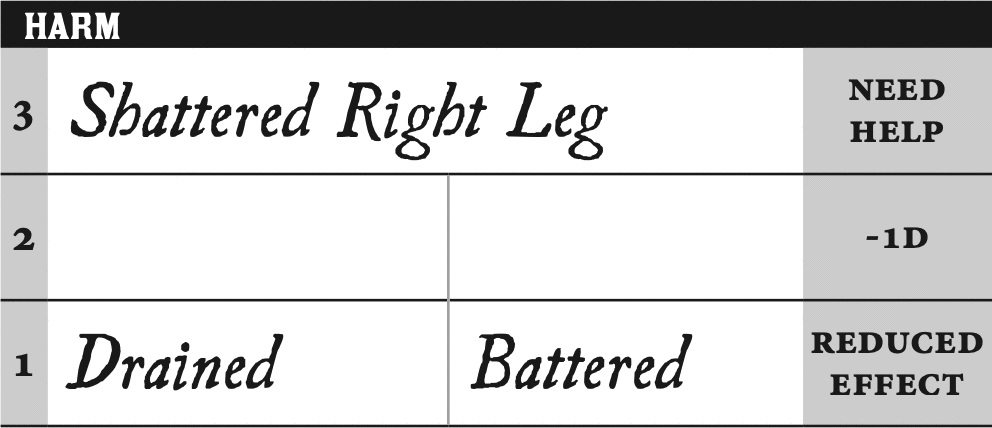Enemy actions, bad circumstances, or the outcome of a roll can inflict consequences on a PC. There are five types (at right).
A given circumstance might result in one or more consequences, depending on the situation. The GM determines the consequences, following from the fiction and the style and tone established by the game group.
Reduced Effect
This consequence represents impaired performance. The PC’s action isn’t as effective as they’d anticipated. You hit him, but it’s only a flesh wound. She accepts the forged invitation, but she’ll keep her eye on you throughout the night. You’re able to scale the wall, but it’s slow going—you’re only halfway up. This consequence essentially reduces the effect level of the PC’s action by one after all other factors are accounted for.
Complication
This consequence represents trouble, mounting danger, or a new threat. The GM might introduce an immediate problem that results from the action right now: the room catches fire, you’re disarmed, the crew takes +1 heat from evidence or witnesses, you lose status with a faction, the target evades you and now it’s a chase, reinforcements arrive, etc.
Or the GM might tick a clock for the complication, instead. Maybe there’s a clock for the alert level of the guards at the manor. Or maybe the GM creates a new clock for the suspicion of the noble guests at the masquerade party and ticks it. Fill one tick on a clock for a minor complication or two ticks for a standard complication.
A serious complication is more severe: reinforcements surround and trap you, the room catches fire and falling ceiling beams block the door, your weapon is broken, the crew suffers +2 heat, your target escapes out of sight, etc. Fill three ticks on a clock for a serious complication.
Don’t inflict a complication that negates a successful roll. If a PC tries to corner an enemy and gets a 4/5, don’t say that the enemy escapes. The player’s roll succeeded, so the enemy is cornered... maybe the PC has to wrestle them into position and during the scuffle the enemy grabs their gun.
Lost Opportunity
This consequence represents shifting circumstance. You had an opportunity to achieve your goal with this action, but it slips away. To try again, you need a new approach—usually a new form of action or a change in circumstances. Maybe you tried to Skirmish with the noble to trap her on the balcony, but she evades your maneuver and leaps out of reach. If you want to trap her now you’ll have to try another way—maybe by Swaying her with your roguish charm.
Worse Position
This consequence represents losing control of the situation—the action carries you into a more dangerous position. Perhaps you make the leap across to the next rooftop, only to end up dangling by your fingertips. You haven’t failed, but you haven’t succeeded yet, either. You can try again, re-rolling at the new, worse position. This is a good consequence to choose to show escalating action. A situation might go from controlled, to risky, to desperate as the action plays out and the PC gets deeper and deeper in trouble.
Harm
This consequence represents a long-lasting debility (or death). When you suffer harm, record the specific injury on your character sheet equal to the level of harm you suffer. If you suffer lesser harm, record it in the bottom row. If you suffer moderate harm, write it in the middle row. If you suffer severe harm, record it in the top row. See examples of harm and the harm tracker, below.
Your character suffers the penalty indicated at the end of the row if any or all harm recorded in that row applies to the situation at hand. So, if you have “Drained” and “Battered” harm in the bottom row, you’ll suffer reduced effect when you try to run away from the constables. When you’re impaired by harm in the top row (severe harm, level 3), your character is incapacitated and can’t do anything unless you have help from someone else or push yourself to perform the action.
If you need to mark a harm level, but the row is already filled, the harm moves up to the next row above. So, if you suffered standard harm (level 2) but had no empty spaces in the second row, you’d have to record severe harm (level 3), instead. If you run out of spaces on the top row and need to mark harm there, your character suffers a catastrophic, permanent consequence (loss of a limb, sudden death, etc., depending on the circumstances).

Harm examples
Fatal (4): Electrocuted, Drowned, Stabbed in the Heart.
Severe (3): Impaled, Broken Leg, Shot in Chest, Badly Burned, Terrified.
Moderate (2): Exhausted, Deep Cut to Arm, Concussion, Panicked, Seduced.
Lesser (1): Battered, Drained, Distracted, Scared, Confused.
Harm like “Drained” or “Exhausted” can be a good fallback consequence if there’s nothing else threatening a PC (like when they spend all night Studying those old books, looking for any clues to their enemy’s weaknesses before he strikes).